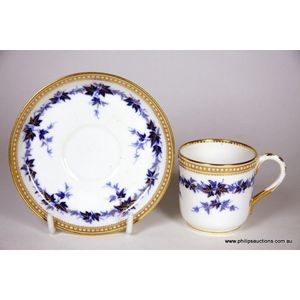Sevres Cup and Saucer with Louis XVI Portrait Medallion
You must be a subscriber, and be logged in to view price and dealer details.
Subscribe Now to view actual auction price for this item
When you subscribe, you have the option of setting the currency in which to display prices to $Au, $US, $NZ or Stg.
- Floral Swag / Garland / Festoon - Floral swags are a decorative motif often used in the ornamentation of various objects, such as silverware, glassware, and furniture. The term "swag" refers to a garland or wreath of flowers, foliage, or other decorative elements, which is usually arranged in a loop or curve.
Floral swags can be found in a variety of decorative styles, from ornate Baroque and Rococo designs to more naturalistic Art Nouveau and Art Deco styles. They are often used to add a touch of elegance, refinement, or whimsy to an object, and can be seen on a range of items from chandeliers and candlesticks to picture frames and tea sets.
In the decoration of silver objects, floral swags are often used to accentuate the curves and lines of the piece, and to add visual interest to the surface. Similarly, on glass objects, floral swags may be used to frame or highlight a particular area of the object, or to add a touch of color and delicacy.
On furniture, floral swags can be found on a variety of pieces, from cabinets and armoires to chairs and sofas. They are often used to enhance the lines and curves of the furniture, and can be used to create a sense of movement and flow in the design.
Overall, floral swags are a versatile decorative element that can be adapted to a range of styles and applications, and have been used in the decoration of various objects throughout history. - Gilding - Gilding is a method of ornamentation whereby a thin sheet of gold metal is applied to items made of wood, leather, ceramics, glass and silver for decorative purposes.
For furniture including mirrors, the sheet of gold is usually applied over a coating of gesso. Gesso is a mixture of plaster of Paris and gypsum mixed with water and then applied to the carved wooden frames of mirrors and picture frames as a base for applying the gold leaf. After numerous coats of gesso have been applied, allowed to dry and then sanded a coat of "bole", a usually red coloured mixture of clay and glue is brushed on and allowed to dry, after which the gold leaf is applied. Over time parts of the gilding will rub off so the base colour can be seen. In water gilding, this was generally a blue colour, while in oil gilding, the under layer was often yellow. In Victorian times, gilders frequently used red as a pigment beneath the gold leaf.
Metal was often gilded by a process known as fire gilding. Gold mixed with mercury was applied and heated, causing the mercury to evaporate, the long-term effect of which was to kill or disable the craftsman or woman from mercury poisoning. The pursuit of beauty has claimed many victims, not the least of which were the artists who made those pieces so highly sought after today. - Bleu Celeste - "Bleu céleste" is a French term that translates to "sky blue" in English, and it refers to a specific shade of blue pigment used in the decoration of porcelain. This color is a light, sky-blue shade that was often used in combination with other colors to create intricate designs on porcelain pieces. The use of "bleu céleste" was was first used by the Sèvres porcelain factory in the 18th century, and became popular in the 19th century. The colour is created by adding copper oxide to the glaze. It was valued for its ability to add a touch of lightness and delicacy to porcelain designs. The color was often used to create floral motifs, landscapes, and other decorative elements, and it was prized for its ability to evoke feelings of calmness and serenity.
- Roundel - A roundel is a circular disk, medallion or border on a plate or dish, on an object of furniture. A plate or dish will often have a central circular bordered decoration, termed a roundel. In furniture the word is often used instead of the word 'patera' to describe a turned circular decoration. In recent times use of the word has expanded to encompass any circular area on an object.
This item has been included into following indexes:
- Sevres (France) and Sevres style, items
Visually similar items

Two Bleu Celeste bordered plates in the Sevres style, early 20th century, both with three gilt decorated floral reserves to the bleu celeste borders, one centred with a romantic scene, the other with a pair of cupids and musical trophies, bearing blue pain

Seven Staffordshire Royal Myott's crown pheasant decal soup bowls, with matching pair of serving plates, & one gravy dish, diameter 20 cm [soup]

A Royal Worcester demitasse cup and saucer, 1878, pattern B 379, with trailing borders of dark and light blue ivy and gilded highlights with jewelled borders upon a white ground; with puce backstamp, pattern number and decorator's mark underside. Height 5.

An Adams, Staffordshire, over-sized 'Farmer's arms' cup and saucer, first half 20th century, each piece with hand-coloured transfer-printed agricultural-themed decoration and the verse 'God speed the plough', printed mark to the undersides. Height 9.5 cm (
